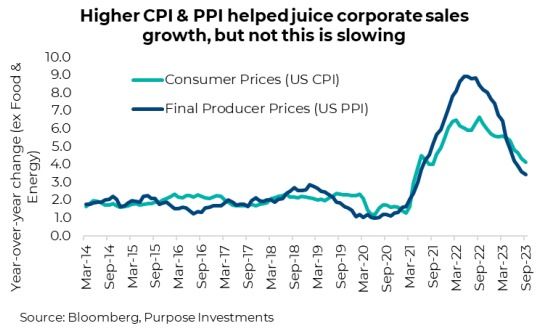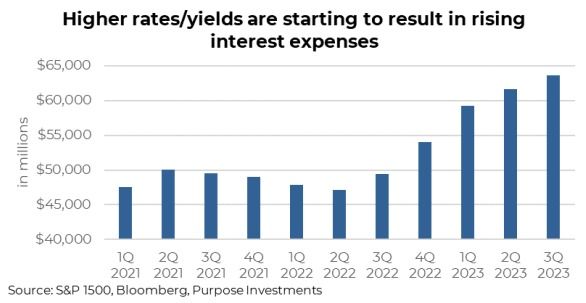Earnings Hits and Misses
We are about halfway through the U.S. earnings season, with 245 of the S&P 500 having already reported. Earnings are rather backward-looking, kind of like GDP reports, since the quarter started in July and ended in September. Nonetheless, companies offer a direct look at what is happening on the ground and their expectations for the coming quarters delivered via guidance. We would include Canadian earnings as well, but only 14% of the TSX has reported. Things move a little slower up here. So, let’s dive into U.S. earnings.
There is some good news: earnings growth has returned. After three quarters of negative or no earnings growth, Q3 2023 earnings appear to be coming in at about +5% compared to the same quarter last year. Based on current bottom-up analyst estimates, earnings growth is expected to continue to improve up to about 10% or so.

Continuing on a positive note, about 80% of companies have so far surprised to the upside. That is in keeping with historical norms. Impressively, this was widespread across all sectors except Energy. Growth, too, was widespread, with all sectors except Energy, Materials and Real Estate showing positive earnings improvement over last year. With commodity prices lower than a year ago, that is what drives the earnings in Energy and Materials, so it is not surprising. And, of course, Real Estate continues to struggle. Margins have also remained resilient. Yes, costs are up, but so is top-line revenue growth for most firms. Overall, it was a decent earnings season so far.
While on aggregate, it does appear that things are holding up or even improving from an earnings perspective. But it is important to remember periods of higher inflation create a great deal of confusion, not just for people making decisions but for businesses and even for economists. Inflation churns up the water, making it hard to see what is happening in the economy.

There is no denying higher inflation helped offset higher input costs to maintain margins and help restore earnings growth. The question is not what happens as prices and producer prices come back down. Without the ability to raise prices, either input costs have to reverse as well, or margins suffer.
So, will input costs come down? Ford appears to have resolved the strike and, as a result, removed profit forecasts. Sure sounds like input costs may keep going up even as inflation comes down. This may put margins at labour-intensive industries at greater risk in the coming quarters.

There is another cost that is starting to bite: interest expense. In 2022, when yields started to rise, there was much talk about how great a job corporate America did on extending the terms of their debt when yields were so low. Absolutely true, and this has helped. But as time goes by, it starts to show up more and more as rising interest expense.

Final Thoughts
We are encouraged so far by this earnings season, but we also are starting to see forward estimates come under a bit of pressure. It is important to focus on the composition of companies, their ability to pass through costs, how labour-intensive their operations are, and what the debt situation looks like.
Estimates for 2024 remain too high in our opinion for the S&P 500, and we believe this adds to risk. Canada and most international markets have already seen a rapid decline in estimates, which does provide a margin of safety. U.S. earnings appear the most at risk, but it really depends on the industry and the company.
Sorry, there is no quick and easy shortcut here, just the conclusion that digging deeper into fundamentals is becoming increasingly important in this challenging market.
— Craig Basinger is the Chief Market Strategist at Purpose Investments
Disclaimers
Source: Charts are sourced to Bloomberg L.P. and Purpose Investments Inc.
The contents of this publication were researched, written and produced by Purpose Investments Inc. and are used by Echelon Wealth Partners Inc. for information purposes only.
This report is authored by Craig Basinger, Chief Market Strategist, Purpose Investments Inc.
Insurance products and services are offered by life insurance licensed advisors through Chevron Wealth Preservation Inc., a wholly owned subsidiary of Echelon Wealth Partners Inc. This material is provided for general information and is not to be construed as an offer or solicitation for the sale or purchase of life insurance products or securities mentioned herein. Every effort has been made to compile this material from reliable sources however no warranty can be made as to its accuracy or completeness. Before acting on any of the above, please seek individual financial advice based on your personal circumstances. Please note that only Echelon Wealth Partners is a member of CIPF and regulated by IIROC; Chevron Wealth Preservation is not.
Forward-looking statements are based on current expectations, estimates, forecasts and projections based on beliefs and assumptions made by author. These statements involve risks and uncertainties and are not guarantees of future performance or results and no assurance can be given that these estimates and expectations will prove to have been correct, and actual outcomes and results may differ materially from what is expressed, implied or projected in such forward-looking statements.
The opinions expressed in this report are the opinions of the author and readers should not assume they reflect the opinions or recommendations of Echelon Wealth Partners Inc. or its affiliates. Assumptions, opinions and estimates constitute the author’s judgment as of the date of this material and are subject to change without notice. We do not warrant the completeness or accuracy of this material, and it should not be relied upon as such. Before acting on any recommendation, you should consider whether it is suitable for your particular circumstances and, if necessary, seek professional advice. Past performance is not indicative of future results. These estimates and expectations involve risks and uncertainties and are not guarantees of future performance or results and no assurance can be given that these estimates and expectations will prove to have been correct, and actual outcomes and results may differ materially from what is expressed, implied or projected in such forward-looking statements. Echelon Wealth Partners Inc. is a member of the Investment Industry Regulatory Organization of Canada and the Canadian Investor Protection Fund.



Call our office today for a private consultation about your Beyond Wealth needs.
All Rights Reserved | Ottawa Wealth Management
Please note that only Echelon Wealth Partners is a member of CIPF and regulated by IIROC; Chevron Wealth Preservation Inc. is not. *Insurance Products provided through Chevron Preservation Inc.



